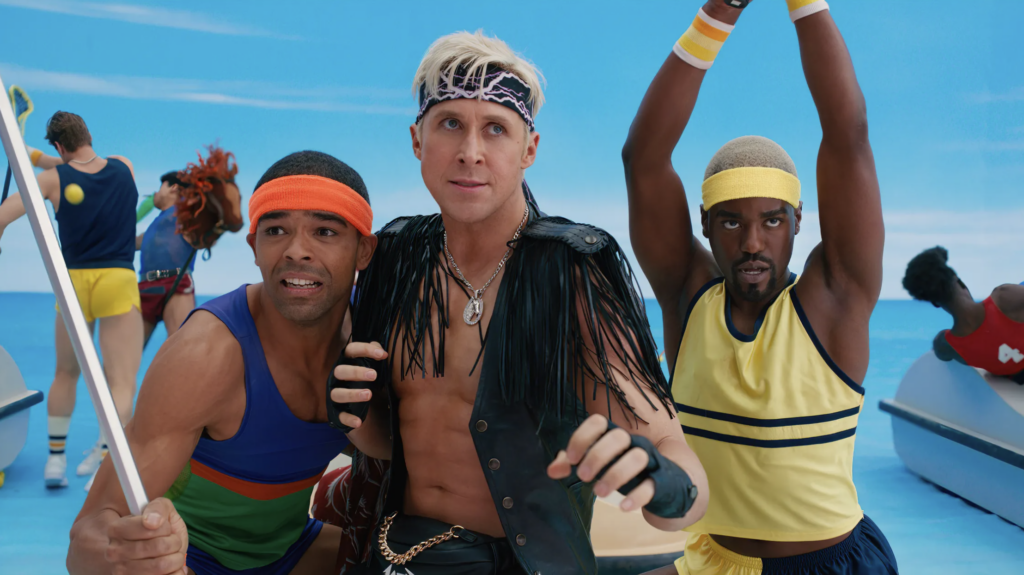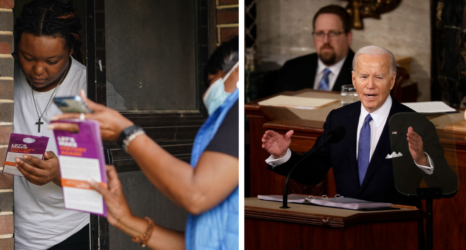In Barbie, the problem isn’t Barbie, Ken or anyone else. It is the patriarchy—which excludes and punishes women, but also harms men. And many men got it.

Right-wing reaction against a feminist film about Barbie was predictable. The iconic status of Barbie in the American psyche, and the movie’s massive marketing campaign ahead of its launch, were already sending clear signals about its potential to be a summer blockbuster.
What wasn’t as predictable was that some of the earliest attacks on Greta Gerwig’s megahit would focus less on its treatment of Barbie than its depiction of … Ken. As soon as the movie hit theaters, right-wing commentators excoriated the film as an exercise in unapologetic male-bashing. Conservative Daily Wire founder Ben Shapiro, in a 43-minute screed against the movie, called it “a flaming pile of dog [excrement],” and “one of the worst movies I’ve ever seen,” and said, “The entire movie is about how men are evil and terrible.” British TV personality Piers Morgan said the movie was “not just an attack on Ken, but on all men.”
Except it wasn’t.
In fact, the storyline around Ken was, in many ways, deeply empathetic with men. To be sure, the film’s main narrative highlights the many struggles of modern Western women, as told satirically through the odyssey of a famous female doll. But one reason the film has captured the zeitgeist is that Ken was more than an afterthought.
The idea that feminism has many deeply insightful, constructive and hopeful things to say to men and their struggles presents a direct threat to the right.
Despite right-wing warnings to stay away, 40 percent of the opening weekend theatergoers to Barbie were men and boys.
If the film has what might be called a thesis statement, it is about the ways in which patriarchy as an economic, social and political system has damaging—and often disastrous—effects on women and people with marginalized gender identities, but also on its supposed primary beneficiary: men. Even heteronormative white men. This is a standard feminist insight that should be familiar to anyone who’s taken a gender studies course, read feminist books, or talked with feminist women and men over the past couple of generations.
But the idea that feminism has many deeply insightful, constructive and hopeful things to say to men and their struggles presents a direct threat to the right. Because what if growing numbers of men began to wake up and realize that not only is feminism not their enemy, but in fact has many valuable things to contribute to building healthier societies and improving their lives?
Right-wing authoritarian regimes in deeply patriarchal cultures understand the threat this awareness poses. That’s why illiberal countries like Hungary and Poland have already taken steps to limit the teaching of “gender” in public schools, and why American politicians like Florida Governor Ron DeSantis (R) have made government-mandated restrictions on the teaching of topics like gender and race a major part of their “culture wars” pitch to conservative voters.
But the classroom is hardly the only site for the transmission of ideas and ideologies. Media culture plays a crucial role. Because it was such a well-written and acted piece of cinematic satire that appeals, in different ways, to audiences of all ages, and because it covers such important subject matter, the Barbie movie is an invaluable resource for people who teach media literacy. That means teachers and professors, but also parents and other adults who are influential in the lives of young people. What’s more, the learning environment is expansive: from the classroom, to the living room, and beyond.
The eminent cultural studies theorist Douglas Kellner has written, “Since we are immersed from cradle to grave in a media culture and society, it is important to learn how to understand, interpret and criticize its meanings and messages. The media are a profound and often misperceived source of cultural pedagogy.”
Kellner also wrote that in advanced capitalist societies, “media and consumer culture work hand-in-hand to generate thought and behavior that conform to existing values, institutions, beliefs, and practices. …Yet audiences are not simply or solely brainwashed, and may resist dominant meanings, values, and messages, and create their own readings and appropriations of mass-produced culture. … Hence, media culture itself provides resources that individuals can emulate and modify, or reject, in forming their own identities against dominant models.”
One of the many ironies of Barbie‘s phenomenal commercial success is that the “private” market has created a “teachable moment” that has the power to reach tens of millions of people—including untold numbers of boys and men—with potentially subversive feminist ideas they would otherwise rarely encounter. According to a headline in Rolling Stone, “‘Barbie’ may be the most subversive blockbuster of the 21st century.”
Barbie’s rich and multi-layered script gives us the opportunity to explore a wide range of topics. Of course, most analysis and commentary about the film focuses—like the movie itself—on the lives of women and their subordinate economic and social position in patriarchy. But in the spirit of the film’s overarching critique of patriarchy’s harmful effects on everyone, Ken’s storyline offers the opportunity to examine a range of topics.
Men’s Ability to Empathize With Women’s Experiences
Many times during the film, Ryan Gosling’s Ken expresses sadness and disappointment that Barbie doesn’t see or value him. He is reduced, quite literally, to the status of an object. This role reversal is one of the story’s signature devices; the satire works because men’s objectification of women is such a pervasive feature of Western society.
In light of the film’s historic numbers at the box office, it seems worth asking the film’s critics why they think so many women and girls love the movie (about a doll!) and deeply identify with the themes it raises about women’s lives. Have they all been duped by feminist propaganda?
For men who are willing to listen and learn, one of the first questions they might consider asking women is why the film resonates so strongly with them. This includes many feminists who were initially skeptical because of Barbie’s identification with traditional femininity, but many who were nonetheless moved by the film. Men who have the self-confidence, curiosity, and/or relational skill to ask women these sorts of questions might learn a lot from the answers they get.

Another conversation starter concerns one of the film’s most powerful scenes, in which Barbie and Ken are roller-blading on Venice Beach in the “Real World.” Ken is happily blading along, enthralled with his newfound power and visibility, while Barbie encounters a stream of harassing comments from men that make her fearful of the danger that lurks beneath men’s attention.
How many women can relate viscerally to that experience? And how many men have been in Ken’s position, blissfully unaware of how misogyny, and men’s violence, shape women’s psyches and limit their freedoms on a daily basis?
The Invisibility of Privilege
At one point Ken says: “Why didn’t Barbie tell me about patriarchy?”
Working with men on issues of gendered inequality can be challenging because many of them don’t see themselves as even having privilege. This is related to the phenomenon of white people who are unable or unwilling to engage in introspection about their part in perpetuating racism.
People in dominant groups are often unable to see these things precisely because that is the way privilege works: by remaining invisible to those whom it advantages. In addition, many people—especially, but not exclusively, in the U.S.—have been conditioned to think in individual terms. “I’m not a misogynist,” they’ll say. “I’m not a racist,” as if this is about personality traits, rather than systems and social structures.
The Barbie film makes clear that the problem isn’t Barbie, Ken or any other individual. It is patriarchy—a social and political system that was set up by and for men. Women are the biggest losers in this system. And of course, some men get a lot from it, especially wealthy cisgender, heteronormative heterosexual white men.
But it gets complicated: Not all men benefit equally—or at all. Multitudes of men lose out because they’re not “man enough” to be respected by the dominant culture, or they don’t belong to the most powerful ethnic/racial group, or because they occupy marginalized gender/sex identities. One of the dirty little secrets of patriarchy is that not only does it exclude and punish women; but it also harms men who don’t meet the very narrow definitions of “manhood” that are most favored.
‘I’m not a misogynist,’ they’ll say. ‘I’m not a racist,’ as if this is about personality traits, rather than systems and social structures.
Pink Used to Be a Men’s Color, and Other Insights From Feminism 101
The Barbie movie, and the doll itself, are inextricably linked to the color pink—a supposedly “feminine” color. But there is more to the story.
Pink only became identified as a women’s color in the 1940s, when retailers and manufactures made it so. For centuries it was associated with men, as red was seen as the color of passion and aggression, a “masculine” color. Pink was the boys’ version.
How many of the Barbie movie’s conservative anti-feminist critics—who often mock the idea that gender is a social construct—know any of this?
One of the greatest gifts that Greta Gerwig and her many collaborators have given to the masses is the mainstreaming of critical feminist insights. These masses include the millions of men (and women!) who graduated from college without ever taking a course taught by a feminist on the sociology, psychology or politics of gender, and thus missed being introduced to an analytic framework that explains an awful lot about what’s going on in our society, at both the personal and political levels—for men, as much as for women.
The philosopher Susan Bordo has written, “If you know anything about feminist writing about Barbie, fashion, consumerism, masculinity, diversity, girlhood, you’ll recognize how much of [the movie] relied on the best of feminism—of all the generations—without declaring any iteration the ‘correct’ one. And in doing so, it winked at (and then demolished) all the stereotypes—not just about gender, but about feminism. We inform the entire script of Barbie.”
Ken, Men and Feminism
Since the 1990s, there has been an explosion of scholarship and writing about men’s lives that has been informed by intersectional feminist ideas about masculinities and power. In fact, a multiracial, multiethnic movement of pro-feminist men has been organizing, agitating and trying to break through into mainstream discourse and consciousness since the 1970s.
But judging by the near absence of any acknowledgment it has received in recent media coverage of a “crisis in masculinity,” it appears that few people know this movement even exists. It’s a small but growing (global) movement of men who reject the tired caricature of feminism as anti-male, and instead seek to apply feminist insights to men’s lives in ways that will help women, men and others across the entire range of gender and sexual identities.
Some of the storylines surrounding Ken mirror some of the many themes explored in profeminist men’s studies, including:
- the omnipresent role of violence in men’s lives;
- Ken’s struggle to “man up” by adopting a version of patriarchal masculinity—gleaned from his time in the “Real World”—as a solution to Barbie’s rejection of him; and
- his quest to create a fulfilling sense of self from a smorgasbord of masculine styles on offer over the past couple of generations.
We’re supposed to believe that all of this is unfair to men? Right-wing attacks on Barbie as “anti-male” are even more absurd in light of what many people see as the film’s empathetic treatment of Ken. As Eliana Dockterman wrote in Time magazine, “Ken has the most intriguing and funniest part to play, offering a searing social commentary on modern man’s insecurities dressed up in bubble-gum pink.”
One of the movie’s producers, David Heyman, put it this way: “I think Ryan is undeniable and so affecting in the film. People really care for Ken even when he’s misguided. I think a lot of boys and men will find there’s a lot to relate to in Ken as they try to find their place in the world. But it’s all done with such a light touch and such generosity…”
What more can you ask of a film, especially a summer Hollywood blockbuster? It bears repeating that this is a comedy, intended to make us laugh. For men, this means sometimes laughing at ourselves. The good news is that millions of men have already seen the film and—as evidenced by personal testimony as well as countless positive social media posts—enjoyed it immensely.
It appears that many of us do, in fact, have a sense of humor, and are able to laugh at ourselves and some of the less attractive features of male-dominated cultures without crying foul and embracing an unearned victim status.
Up next:
U.S. democracy is at a dangerous inflection point—from the demise of abortion rights, to a lack of pay equity and parental leave, to skyrocketing maternal mortality, and attacks on trans health. Left unchecked, these crises will lead to wider gaps in political participation and representation. For 50 years, Ms. has been forging feminist journalism—reporting, rebelling and truth-telling from the front-lines, championing the Equal Rights Amendment, and centering the stories of those most impacted. With all that’s at stake for equality, we are redoubling our commitment for the next 50 years. In turn, we need your help, Support Ms. today with a donation—any amount that is meaningful to you. For as little as $5 each month, you’ll receive the print magazine along with our e-newsletters, action alerts, and invitations to Ms. Studios events and podcasts. We are grateful for your loyalty and ferocity.





